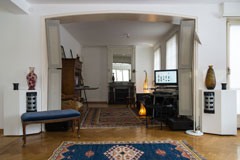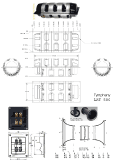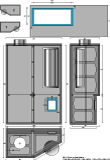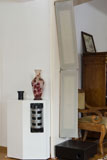Vertically Stacked Planar Magnetic Speakers
This loudspeaker system continues a previous build based on linear arrays of small wide-range drivers. This time, I tried planar magnetic speakers.
I used LinearTeam WinISD speaker designing software, John Mulcahy's REW room acoustics analysis software and Phonic PAA3 31-band real time spectrum analyzer.
Front speakers
Two
Magnepan
MMG W
per channel are stacked to form tall dipolar line sources.
Inspired by
Design Guidelines for Practical NearField Line Arrays, James R. Griffin, 2003:
A near field line array provides a different listening experience versus point source
speakers. Among the distinctions that characterize line arrays are:
· Near constant sound levels throughout the listening room
· A wider soundstage
· An image ‘sweet area’ and not a ‘sweet spot’
· Recreates live event sound dynamics
The bass extension is provided by
Tymphany
Linear Array Transducers
(with a tubular form factor)
LAT 500-4
in 80 liters vented enclosures filled in the bottom third with a polyester fleece.
Bitumen boards damp the inner surfaces.
The baffles are mirror oriented at 30 degrees.
The length of the external 7 cm diameter vent can be adjusted for room response, actually ~15 cm (Fb ~26 Hz).
I added the pair of
TBI
Magellan VIII xu
subwoofers of my
2007 project.
Operating
The speakers are powered by two
Rotel
RMB-1565
5 channels Class D amplifiers, one for each stereo channel.
Loudspeaker filtering and equalization are done by a
Behringer
UltraDrive Pro DCX2496
digital system prepared by Ward Maas at
Pilgham Audio,
following Jan Didden
Linear Audio
modifications: a
linear power supply
replaces the smps and a
6-channel volume control
gives the DCX pre-amp capability.
The 24-bit / 96 kHz digital signal is provided by a Behringer
UltraMatch Pro SRC2496
A/D D/A & sample rate converter. Up to three digital and one analog sources can be connected.
The table below shows the applied filters with the compensations for room effects, phase and loudspeakers linear distortion.
| Section | Sub | Bass | Wide range |
|---|---|---|---|
| Level | -2 dB | –2 dB inverted polarity | 0 dB |
| 111 Hz | low-pass 48 dB Butterworth | low-pass 48 dB Butterworth | |
| 114 Hz | high-pass 48 dB Butterworth | ||
| Parametric Equalization | 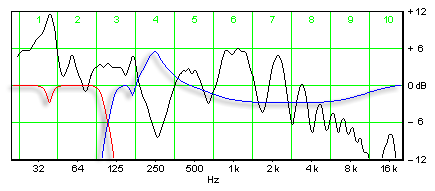
| ||
| 41 Hz
168 Hz 249 Hz 706 Hz 11 kHz | -3 dB Q 10
-3 dB Q 10 +6 dB Q 3.2 -3 dB HS12 +3 dB HS12 | ||
The green grid in the graph shows the ten octaves and a ±12 dB range.
The red and blue lines display the resulting action of the filters on each section.
The black line is the unfiltered frequency response to a log sweep at the listening position, 3.5m away from the speakers, average of two measures, 1/12 octave smoothing. Lack of energy in the midbass, comb filtering and high frequency rolloff are on the menu.
Shocked? Measuring planar speakers in-room produces seldom nice results.
The next figure shows the real time spectrum analysis on pink noise at the listening position, filters applied, average of four measures, and is more representative of what is heard.

Listening
This is my first experience with planar speakers and I'm happy with their natural reproduction, especially of the human voice. The room is filled without pressure. The soundstage is tall, wide and deep, with strong vertical directivity, very precise.
Yet I feel that something is missing: impact. Very enjoyable at moderate levels, it looses relief when played loud. Definitely not suited for funk!
July 2013
 JdM12
JdM12